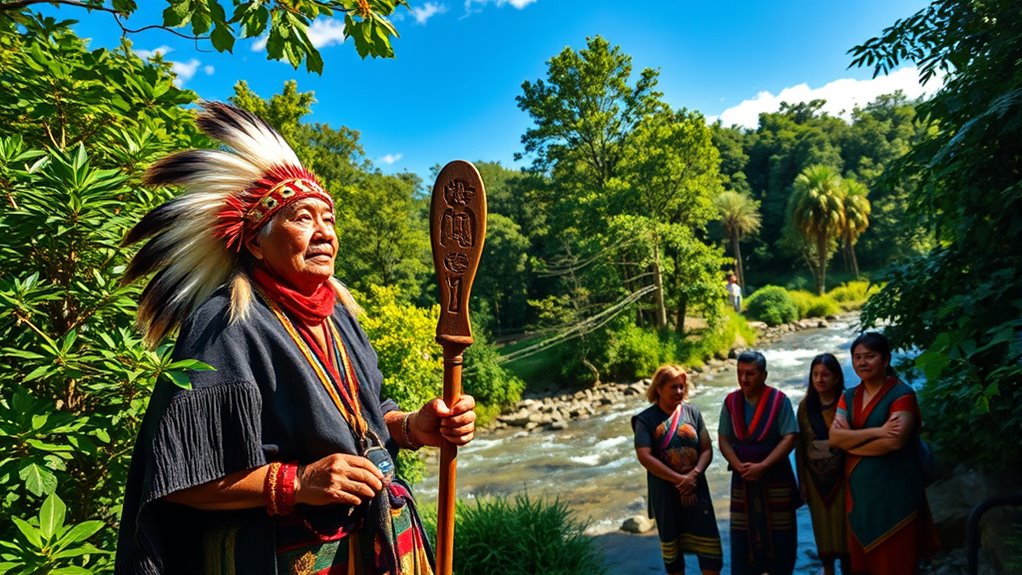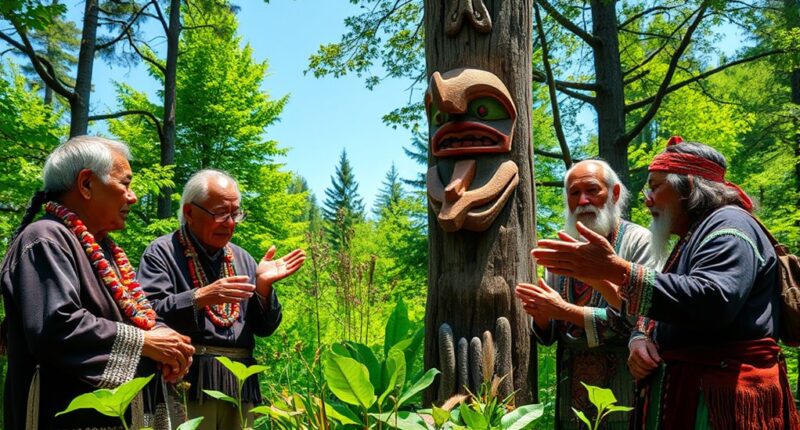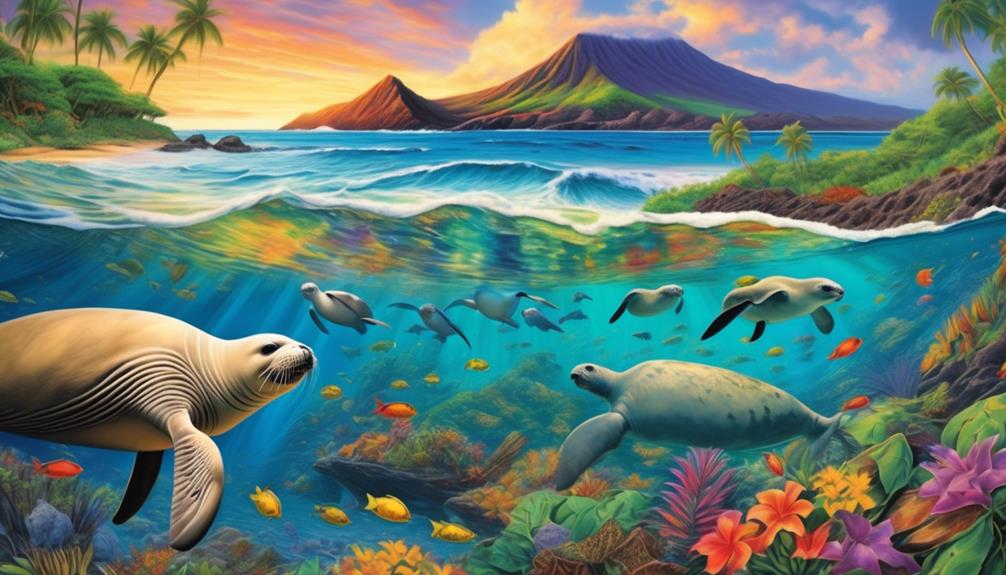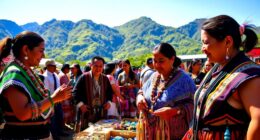Harnessing indigenous knowledge for climate action means recognizing the valuable insights and practices indigenous communities have developed over centuries. These include land stewardship methods like controlled burning, which reduce wildfire risks and enhance ecosystems. They also offer detailed understanding of local environmental changes through traditional ecological knowledge, supporting resilience and climate mitigation. By respecting indigenous rights and collaborating with communities, you can integrate these sustainable practices into broader climate strategies, revealing powerful solutions—stay with us to uncover more about their vital role.
Key Takeaways
- Indigenous ecological practices support ecosystem resilience and enhance climate mitigation through land stewardship and traditional fire management.
- Traditional Ecological Knowledge offers valuable insights into environmental changes, aiding climate resilience and adaptation strategies.
- Integrating indigenous practices into climate policies promotes sustainable resource use and respects land rights.
- Indigenous-led conservation efforts help preserve cultural heritage while contributing to carbon sequestration and ecosystem health.
- Collaboration with indigenous communities ensures inclusive, effective climate action that leverages centuries of environmental expertise.

Harnessing indigenous knowledge offers powerful insights for addressing climate change, as these communities have long-standing relationships with their environments. Your ability to understand and respect these traditional practices can access sustainable solutions rooted in centuries of experience. Indigenous communities have developed land stewardship techniques that harmonize human activity with nature, ensuring ecosystems remain resilient. These practices often involve carefully managing resources, maintaining biodiversity, and respecting seasonal cycles, all of which contribute to climate adaptation and mitigation efforts. Incorporating elements like traditional ecological knowledge can enhance modern conservation strategies. You might find that traditional practices such as controlled burning or agroforestry are effective tools for reducing wildfire risks and enhancing soil health. For example, many indigenous groups intentionally burn small, controlled fires to clear underbrush, which prevents larger, uncontrollable wildfires and promotes new growth. This land stewardship method not only preserves ecosystems but also acts as a natural carbon sink, helping to offset greenhouse gas emissions. Recognizing and integrating such practices into broader climate strategies can lead to more sustainable and culturally respectful approaches.
Indigenous land stewardship balances human activity with nature, promoting resilience and climate solutions through centuries-old practices.
Indigenous land stewardship also emphasizes a deep understanding of local ecosystems, fostering a sense of responsibility for the environment. You can learn how these communities observe subtle changes in weather patterns, animal behaviors, and plant life to make informed decisions about resource use. This traditional ecological knowledge provides valuable data that complements scientific research, offering a holistic perspective on climate resilience. By supporting indigenous-led conservation initiatives, you help safeguard not only the environment but also the cultural heritage embedded within these land stewardship practices. Additionally, embracing traditional ecological knowledge can facilitate more inclusive and effective climate policies. Furthermore, respecting indigenous rights to land and resources is essential for effective climate action. When communities have control over their lands, they are more likely to implement sustainable practices that protect natural resources for future generations. Collaborating with indigenous peoples enables the exchange of knowledge, blending traditional practices with modern science to create innovative solutions. Your role is to listen, learn, and amplify these voices, ensuring that climate policies honor indigenous sovereignty and incorporate their expertise.
Frequently Asked Questions
How Can Indigenous Knowledge Be Integrated Into National Climate Policies?
You can integrate indigenous knowledge into national climate policies by actively consulting Indigenous communities and respecting their traditional practices. Incorporate their insights into policy design through meaningful dialogue and collaboration, ensuring their voices are heard. This involves recognizing the value of traditional practices and embedding them into policy frameworks, promoting policy integration that honors Indigenous ways of knowing. Such steps help create more effective, inclusive climate strategies grounded in local wisdom.
What Are the Challenges of Documenting Indigenous Climate Practices?
You might think documenting indigenous climate practices is simple, but it’s tricky. Oral traditions are fragile and easily lost, making it hard to capture their depth. Protecting their intellectual property is vital, yet often overlooked, risking exploitation. Ironically, digital records can’t fully preserve the nuance, so you must respect cultural sensitivities and guarantee communities control how their knowledge is shared, or risk erasing invaluable wisdom.
How Can Indigenous Youth Be Engaged in Climate Action Initiatives?
You can engage Indigenous youth in climate action by fostering youth leadership and encouraging community participation. Invite them to lead projects, share their perspectives, and develop innovative solutions rooted in their cultural knowledge. Support mentorship programs and create spaces where they feel empowered to voice their ideas. By actively involving them, you help build a strong, resilient community committed to sustainable climate practices and preserving their heritage for future generations.
What Are Successful International Collaborations Involving Indigenous Knowledge?
You can look at successful international collaborations that prioritize cultural preservation and incorporate traditional storytelling, like the Amazonian Indigenous-led projects with global NGOs. These initiatives respect Indigenous knowledge systems and foster mutual learning. By valuing traditional storytelling, you help maintain cultural identity while addressing climate issues collaboratively. Such partnerships empower Indigenous communities, ensuring their knowledge informs sustainable solutions and strengthens the global effort against climate change.
How Do Cultural Beliefs Influence Indigenous Approaches to Climate Resilience?
Your cultural beliefs deeply shape indigenous approaches to climate resilience by emphasizing traditional rituals and cultural values that promote harmony with nature. These rituals reinforce respect for the environment, guiding sustainable practices and community-based solutions. By honoring these traditions, you maintain a strong connection to the land, fostering resilience. Understanding and integrating these cultural frameworks can enhance climate strategies, ensuring they align with indigenous worldviews and promote effective, culturally respectful climate action.
Conclusion
By embracing indigenous insights, you empower effective, equitable environmental efforts. When you listen, learn, and leverage their legacy, you harness history’s harmony to heal today’s habitats. Your commitment to conserving cultures and climates creates a collective, compelling call to action. Together, through trust and tradition, you can turn threats into solutions, transforming tides of trouble into tides of hope. Remember, fostering respect fuels real change—because when indigenous knowledge thrives, our planet truly prospers.
Mary is a passionate writer who brings creativity and a fresh perspective to our team. Her words have the power to captivate and inspire, making her an essential contributor to our content. Mary’s commitment to storytelling and dedication to promoting Indigenous culture ensures that her work touches the hearts of our readers. We’re fortunate to have her as part of our team.









